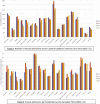Pediatric critical care capacity in Canada
- PMID: 40061244
- PMCID: PMC11885877
- DOI: 10.1093/pch/pxae024
Pediatric critical care capacity in Canada
Abstract
Objectives: Pediatric intensive care unit (PICU) capacity is a current and future health system challenge. Despite experiencing two pandemics in as many decades and surges every winter, we have little to no information on PICU capacity in Canada. Our objective was to characterize the bed capacity of Canadian PICUs and their ability to accommodate surges in demand.
Methods: We conducted a cross-sectional survey to gather information from Canadian PICUs regarding funded/physical beds, unit characteristics, medical staffing, therapies provided, and challenges related to surge management. The survey was completed by a representative from each PICU and validated by PICU Directors. Quantitative survey results were summarized as counts and proportions, while the free-text response was summarized using inductive content analysis.
Results: Representatives from all 19 Canadian PICUs located in 17 hospitals completed the survey and reported having 275 (217 level 3 and 58 level 2) funded beds and 298 physical bed spaces. Of these, 47 beds (35 level 3 and 12 level 2) are in two specialized cardiac PICUs. Roughly 13,385, 13,419, 11,430, and 12,315 children were admitted in the years 2018, 2019, 2020, and 2021, respectively. During a surge, PICUs reported being able to add 5.9 ± 3.4 beds per unit totaling up to 108 temporary surge beds. Several barriers for the successful implementation of surge plans were identified.
Conclusions: Canadian pediatric critical care capacity is comparable to that in many other high-income countries, though our ability to respond to a pandemic/epidemic with significant pediatric critical illness may be limited.
Keywords: Critical care capacity; Healthcare resources; ICU Resources; Intensive care beds; Pandemic preparedness; Surge capacity.
© The Author(s) 2024. Published by Oxford University Press on behalf of the Canadian Paediatric Society.
Conflict of interest statement
All authors: No reported conflicts of interest. All authors have submitted the ICMJE Form for Disclosure of Potential Conflicts of Interest. Conflicts that the editors consider relevant to the content of the manuscript have been disclosed.
Figures




References
-
- Frankel L, Hsu B, Yeh T, et al.Criteria for critical care infants and children: PICU admission, discharge, and triage practice statement and levels of care guidance. Pediatr Crit Care Med 2019;20(9):847–87. - PubMed
-
- Duggal A, Orsini E, Mireles-Cabodevila E, et al.Surge capacity and capability of intensive care units across a large healthcare system: An operational blueprint for regional integration. Am J Disaster Med 2021;16(3):179–92. doi: https://doi.org/10.5055/ajdm.2021.0400 - DOI - PubMed
LinkOut - more resources
Full Text Sources
